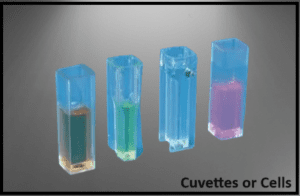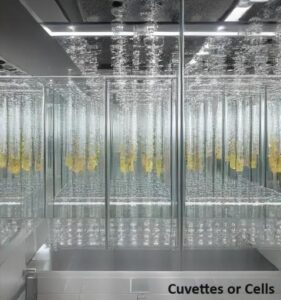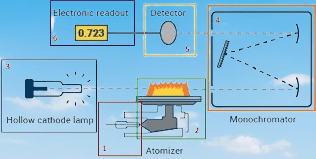Cuvettes and cells play a crucial role in ensuring the integrity of analytical measurements and the reliability of results. These small yet essential tools are employed in various spectroscopic and analytical techniques to maintain high standards of quality and consistency in laboratory practices.
Types and Materials
- Glass Cuvettes: Commonly used in many standard applications due to their excellent optical properties. They are ideal for visible light measurements and are known for their durability and affordability.
- Quartz Cuvettes: Preferred for UV spectroscopy due to their high transparency and low absorbance in the UV range. They provide superior performance in both UV and visible light measurements.
- Plastic Cuvettes: Economical and suitable for disposable use. They are often used in applications where cross-contamination is a concern or where high-quality cuvettes are not required.
- Specialty Cuvettes: These include capillary cuvettes for small volume samples, disposable cuvettes for single-use applications, and cuvettes with unique features like thermostatted conditions for temperature-sensitive measurements.

Applications in Quality Control:
- Spectroscopic Analysis: Cuvettes are indispensable in spectroscopic techniques such as UV-Vis spectroscopy, fluorescence spectroscopy, and colorimetry. By providing a standardized path length for light to pass through, they ensure accurate and reproducible measurement of absorbance or fluorescence, critical for assessing the quality of products and raw materials.
- Calibration and Validation: In QC labs, calibration of instruments is crucial for accurate measurement. Cuvettes with known properties are used to calibrate spectrophotometers and other analytical devices. This ensures that the instruments are functioning correctly and producing reliable data.
- Product Quality Testing: Cuvettes are used to test the quality of pharmaceutical products, chemicals, and food and beverage items. By analyzing the optical properties of these samples, labs can detect impurities, measure concentrations, and ensure that products meet specified standards.
- Environmental Monitoring: In environmental QC labs, cuvettes are used for testing water quality, air pollutants, and soil samples. This includes measuring parameters like turbidity, concentration of contaminants, and other critical factors that affect environmental safety and compliance.
Key Considerations:
- Material Compatibility: Selecting the appropriate cuvette material based on the type of measurement and sample is essential. For instance, quartz cuvettes are necessary for UV measurements, while plastic cuvettes are suitable for visible light applications.
- Path Length and Volume: The path length of a cuvette affects the sensitivity and accuracy of measurements. Commonly, cuvettes have a 10 mm path length, but variations are available for specific needs. The volume of the cuvette should also match the sample volume requirements of the analytical method used.
- Cleaning and Maintenance: Proper cleaning and maintenance of cuvettes are vital to avoid contamination and ensure accurate results. Special cleaning protocols may be required depending on the cuvette material and the nature of the samples.
- Disposable vs. Reusable: Depending on the application, QC labs may choose between disposable cuvettes for single-use convenience and cost-effectiveness, or reusable cuvettes that require thorough cleaning and handling.
Techniques for Using Cuvettes or Cells in Spectroscopy
Using cuvettes or cells in spectroscopy requires careful attention to detail to ensure accurate and reliable measurements. Here is a step-by-step guide on the technique for using cuvettes or cells in laboratory settings:
1. Selection of Cuvettes
- Material: Choose the appropriate material for the cuvette based on the type of spectroscopic analysis.
- Quartz: Ideal for UV spectroscopy (200-400 nm) as it is transparent to UV light.
- Glass: Suitable for visible light measurements (400-700 nm).
- Plastic: Suitable for general use and disposable applications but not for UV measurements.
- Path Length: Standard cuvettes have a 10 mm path length, but other lengths (1 mm, 5 mm, etc.) are available depending on the sample concentration and required sensitivity.
2. Preparation of Cuvettes
- Cleaning: Clean the cuvettes thoroughly before use to avoid contamination.
- Rinse with distilled water.
- Use a suitable solvent (ethanol, acetone) for stubborn residues.
- Rinse again with distilled water and allow to dry completely or use compressed air.
- Handling: Handle cuvettes by the frosted or opaque sides to avoid fingerprints on the clear optical surfaces.
3. Sample Preparation
- Concentration: Prepare the sample solution at the appropriate concentration for the spectroscopic method being used.
- Filling the Cuvette:
- Fill the cuvette to the appropriate level, typically about 3/4 full, ensuring no air bubbles are present.
- Use a pipette or dropper for precise filling.
- Sealing: If required, seal the cuvette with a stopper or cap to prevent evaporation or contamination.
4. Calibration and Blanking
- Blank Solution: Prepare a blank solution that contains all components except the analyte of interest.
- Zeroing the Instrument:
- Insert the blank cuvette into the spectrometer.
- Set the instrument to zero or calibrate it using the blank to account for any absorbance by the solvent and the cuvette itself.
5. Measurement
- Inserting the Cuvette:
- Ensure the clear sides of the cuvette are aligned with the light path of the spectrometer.
- Insert the cuvette gently into the cuvette holder to avoid spillage or damage.
- Recording Data:
- Close the spectrometer compartment to prevent stray light.
- Initiate the measurement process according to the instrument’s protocol.
- Record the absorbance, transmission, or fluorescence data as required.
6. Post-Measurement Procedures
- Cleaning: Immediately clean the cuvette after use to prevent residue build-up.
- Storage: Store cuvettes in a clean, dry place to avoid contamination and damage.
7. Specific Techniques for Different Instruments
- Spectrophotometers: Ensure the wavelength setting is appropriate for the analyte being measured. Use quartz cuvettes for UV measurements and glass or plastic for visible light.
- Fluorometers: Use cuvettes with minimal fluorescence background. Ensure the sample does not quench the fluorescence signal.
- Colorimeters: Select cuvettes that match the filter set used in the colorimeter. Ensure the color filter corresponds to the absorption peak of the analyte.
8. Troubleshooting
- Air Bubbles: Remove any air bubbles by gently tapping the cuvette or using a pipette to dislodge them.
- Contaminants: If unexpected peaks or absorbance values are observed, check for contaminants and clean the cuvette thoroughly.
- Instrument Calibration: Regularly calibrate the spectrometer to ensure accuracy and reproducibility of results.

Frequently Asked Questions (FAQ’s)
What is a sample cell or cuvette?
Answer: A sample cell or cuvette is a small, transparent container used to hold liquid samples for spectroscopic analysis. It allows light to pass through the sample so its properties can be measured.
What is the use of cuvette in laboratory?
Answer: In a laboratory, cuvettes are used in various spectroscopic instruments such as spectrophotometers, colorimeters, and fluorometers to measure the absorbance, transmission, or fluorescence of liquid samples.
What is the difference between a flow cell and a cuvette?
Answer: A flow cell is a type of cuvette designed for continuous flow of liquid samples, allowing for real-time monitoring and analysis. A standard cuvette is typically used for static samples, where the liquid remains stationary during measurement.
Which cuvette is used in colorimeter?
Answer: Glass or plastic cuvettes with a standard 10 mm path length are commonly used in colorimeters, depending on the wavelength range of the measurement and the nature of the sample.
Is it cell or cuvette?
Answer: Both terms are used interchangeably. “Cuvette” is more commonly used in the context of spectroscopic analysis, while “cell” can refer to various types of sample containers in laboratory settings.
What are sample cells?
Answer: Sample cells are containers used to hold liquid samples for analysis in various instruments, similar to cuvettes. They come in different shapes, sizes, and materials depending on the application.
What cuvette to use?
Answer: The choice of cuvette depends on the type of measurement, the wavelength range, and the nature of the sample. Quartz cuvettes are used for UV measurements, glass cuvettes for visible light, and plastic cuvettes for general purposes or disposable use.
What is sample cells in UV spectroscopy?
Answer: Sample cells in UV spectroscopy are typically quartz cuvettes because quartz is transparent to UV light, allowing accurate measurement of absorbance in the UV range.
What is the sample size of a cuvette?
Answer: The sample size or volume that a cuvette can hold varies, but standard cuvettes typically hold about 3 mL. Micro and ultra-micro cuvettes can hold as little as a few microliters.
What are the cells in a spectrophotometer?
Answer: The cells in a spectrophotometer are the cuvettes or sample holders that contain the liquid samples being analyzed for their absorbance or transmission properties.
How to clean a cuvette?
Answer: To clean a cuvette, rinse it with distilled water, followed by a suitable solvent (like ethanol or acetone) if needed. Use a soft brush to remove any residues and dry it with compressed air or a lint-free cloth. Avoid touching the optical surfaces.
Why glass cuvette is used in UV?
Answer: Glass cuvettes are generally not used in UV because glass absorbs UV light. Instead, quartz cuvettes are used for UV spectroscopy as they allow UV light to pass through without significant absorption.
How to prepare cuvette?
Answer: To prepare a cuvette, rinse it with distilled water and the solvent used for the sample. Fill it with the sample to the required volume, ensuring no air bubbles, and wipe the exterior with a lint-free cloth before placing it in the instrument.
Why are cuvettes used?
Answer: Cuvettes are used to hold samples in a controlled path length for accurate spectroscopic measurements. They ensure that the sample is positioned correctly for consistent and reliable data collection.
What happens if a cuvette is dirty?
Answer: If a cuvette is dirty, it can scatter light and cause inaccuracies in the measurement, leading to erroneous results. Contaminants can also absorb light, affecting the sample’s apparent absorbance or transmission.
Why use a blank cuvette?
Answer: A blank cuvette, containing only the solvent or medium without the analyte, is used to zero the spectrophotometer. This accounts for any absorbance due to the solvent or cuvette itself, ensuring accurate measurement of the analyte.
What is cuvette made of?
Answer: Cuvettes can be made of various materials, including glass, quartz, and plastic. The choice of material depends on the wavelength range and type of analysis being conducted.
What are the qualities of a good cuvette?
Answer: A good cuvette should have high optical clarity, chemical resistance, a consistent path length, and should not absorb the light wavelength being measured. It should also be easy to clean and handle.
How to use a colorimeter?
Answer: To use a colorimeter, calibrate it with a blank cuvette, fill the cuvette with the sample, insert it into the colorimeter, and record the absorbance or transmission values displayed.
What size are cuvettes?
Answer: Standard cuvettes typically have a 10 mm path length, but sizes can range from 1 mm to 100 mm. The overall dimensions depend on the volume and the specific type of cuvette.
What is the volume of a 1 cm cuvette?
Answer: A standard 1 cm path length cuvette usually holds about 3 mL of liquid, but this can vary depending on the specific design and wall thickness of the cuvette.
What is a cuvette used for in laboratory apparatus?
Answer: In laboratory apparatus, cuvettes are used to hold liquid samples for various spectroscopic measurements, including absorbance, transmission, fluorescence, and more.
How much volume is a 2 mm cuvette?
Answer: A 2 mm path length cuvette typically holds a smaller volume than standard cuvettes, often around 0.7 mL, but this can vary with the specific design.
What is the mL capacity of a cuvette?
Answer: The mL capacity of a cuvette depends on its size and design. Standard 10 mm path length cuvettes typically hold around 3 mL, while micro cuvettes can hold significantly less.
Is a cuvette a test tube?
Answer: A cuvette is not the same as a test tube. While both are used to hold liquids, cuvettes are specifically designed for optical clarity and precise path length for spectroscopic measurements.
What is a cell sample?
Answer: A cell sample in the context of spectroscopy is the liquid or solution held within a cuvette or sample cell for analysis.
What is the principle of UV?
Answer: The principle of UV spectroscopy is based on the absorption of ultraviolet light by a sample, which causes electronic transitions in molecules. The absorbance is measured to determine the concentration and properties of the sample.
Why is toluene used in UV calibration?
Answer: Toluene is used in UV calibration because it has specific absorbance peaks at known wavelengths, making it a reliable standard for checking the wavelength accuracy and performance of UV spectrophotometers.
What is a sample cell used in UV spectroscopy?
Answer: A sample cell used in UV spectroscopy is typically a quartz cuvette, as quartz allows the passage of UV light with minimal absorption, providing accurate measurements.
What is the detector in UV spectroscopy?
Answer: The detector in UV spectroscopy is a photodetector, such as a photomultiplier tube (PMT) or a photodiode array, which measures the intensity of the transmitted light and converts it into an electrical signal.
What is the cell length in UV visible spectroscopy?
Answer: The cell length, or path length, in UV-visible spectroscopy is typically 10 mm, although other lengths like 1 mm, 2 mm, and 5 mm are also used depending on the application.
Which cuvette is used in UV spectroscopy?
Answer: Quartz cuvettes are used in UV spectroscopy because they are transparent to UV light and do not absorb it, ensuring accurate measurements.
What is the range of UV spectroscopy?
Answer: The range of UV spectroscopy is typically from 200 to 400 nm, which covers the ultraviolet region of the electromagnetic spectrum.
What is the principle of spectrophotometer?
Answer: The principle of a spectrophotometer is to measure the amount of light absorbed or transmitted by a sample at specific wavelengths. This measurement is used to determine the concentration and properties of the analyte.
Why is a red filter used in a colorimeter?
Answer: A red filter is used in a colorimeter to isolate the red wavelength range of light. This enhances the sensitivity and accuracy of measurements for samples that absorb in the red region of the spectrum.
What color filter is a colorimeter?
Answer: A colorimeter can use various color filters (red, blue, green, etc.) depending on the specific wavelength range needed for the measurement of the sample.
Why is a blue filter used in a colorimeter?
Answer: A blue filter is used in a colorimeter to isolate the blue wavelength range of light, which is useful for measuring samples that absorb in the blue region of the spectrum.




I really enjoyed this post. The information was clear and very useful!